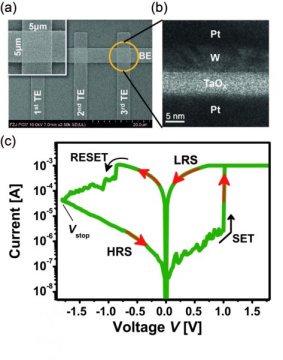
A team of international scientists has
found a way to make memory chips perform computing tasks. The advance means
data could now be processed in the same spot where it is stored, leading to
much faster and thinner mobile devices and computers.
This means data could now be processed in the same spot where it is stored, leading to much faster and thinner mobile devices and computers.
This new computing circuit was developed by Nanyang Technological University, Singapore (NTU Singapore) in collaboration with Germany's RWTH Aachen University and Forschungszentrum Juelich, one of the largest interdisciplinary research centres in Europe.
It is built using state-of-the-art memory chips known as Redox-based resistive switching random access memory (ReRAM). Developed by global chipmakers such as SanDisk and Panasonic, this type of chip is one of the fastest memory modules that will soon be available commercially.
However, instead of storing information, NTU Assistant Professor Anupam Chattopadhyay in collaboration with Professor Rainer Waser from RWTH Aachen University and Dr Vikas Rana from Forschungszentrum Juelich showed how ReRAM can also be used to process data.
This discovery was published recently in Scientific Reports.
Current devices and computers have to transfer data from the memory storage to the processor unit for computation, while the new NTU circuit saves time and energy by eliminating these data transfers.
It can also boost the speed of current processors found in laptops and mobile devices by at least two times or more.
By making the memory chip perform computing tasks, space can be saved by eliminating the processor, leading to thinner, smaller and lighter electronics. The discovery could also lead to new design possibilities for consumer electronics and wearable technology.
How the new circuit works
Currently, all computer processors in the market are using the binary system, which is composed of two states -- either 0 or 1. For example, the letter A will be processed and stored as 01000001, an 8-bit character.
However, the prototype ReRAM circuit built by Asst Prof Chattopadhyay and his collaborators processes data in more than just two states. For example, it can store and process data as 0, 1, or 2, known as a ternary number system.
Because ReRAM uses different electrical resistance to store information, it could be possible to store the data in an even higher number of states, hence speeding up computing tasks beyond current limitations.
Asst Prof Chattopadhyay who is from NTU's School of Computer Science and Engineering, said in current computer systems, all information has to be translated into a string of zeros and ones before it can be processed.
"This is like having a long conversation with someone through a tiny translator, which is a time-consuming and effort-intensive process," he explained. "We are now able to increase the capacity of the translator, so it can process data more efficiently."
The quest for faster processing is one of the most pressing needs for industries worldwide, as computer software is getting increasingly complex while data centres have to deal with more information than ever.
The researchers said that using ReRAM for computing will be more cost-effective than other computing technologies on the horizon, since ReRAMs will be available in the market soon.
Prof Waser said, "ReRAM is a versatile non-volatile memory concept. These devices are energy-efficient, fast, and they can be scaled to very small dimensions. Using them not only for data storage but also for computation could open a completely new route towards an effective use of energy in the information technology."
The excellent properties of ReRAM like its long-term storage capacity, low energy usage and ability to be produced at the nanoscale level have drawn many semiconductor companies to invest in researching this promising technology.
The research team is now looking to engage industry partners to leverage this important advance of ReRAM-based ternary computing.
Moving forward, the researchers will also work on developing the ReRAM to process more than its current four states, which will lead to great improvements of computing speeds as well as to test its performance in actual computing scenarios.

 Previous page
Previous page Back to top
Back to top







